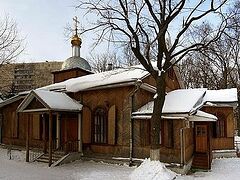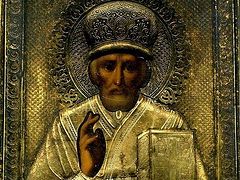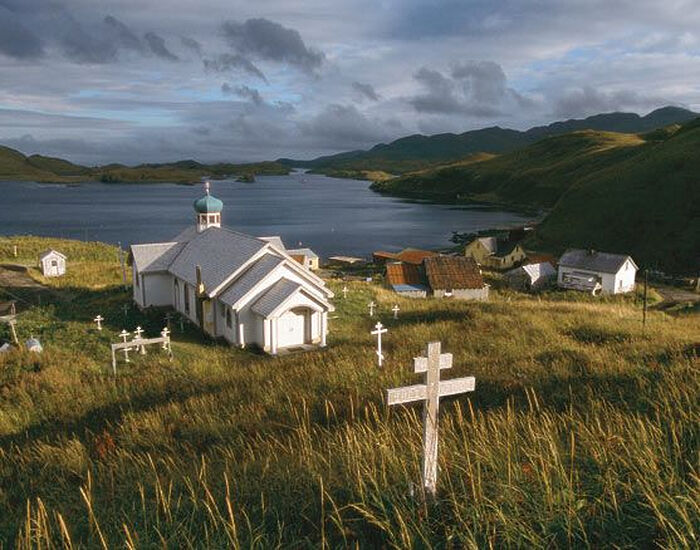 The Church of St. Nicholas on the Western Aleutian island of Atka, Alaska
The Church of St. Nicholas on the Western Aleutian island of Atka, Alaska
“I wonder, who’s been to every country? Just for the sake of visiting them all?”
“They say some Norwegian has.”
“What Norwegian? There was a Japanese man, about thirty years old.”
“I’m telling you it was a Norwegian. And he’s not thirty—he’s sixty-eight.”
“The newspaper said something about some Estonian… or an American. A rich guy.”
This was the argument on a train in the Moscow suburbs, many yeas ago, as one priest told me. It was snowing and evening was coming on. Suddenly an old Siberian man spat in annoyance:
“Oh, you foolish Orthodox. What Japanese guy? It was our Russian, St. Nicholas. He’s definitely been to every country.”
Of course, the Siberian was right. As the Archbishop of Myra in Lycia traveled beyond Asia Minor in the fourth century, so to this day he walks the entire face of the earth.
Wikipedia doesn’t really agree, however. Someone has to explain to Wikipedia, for example, how in Juneau, Alaska, where one and a half thousand Tlingit natives lived, the Church of St. Nicholas the Wonderworker appeared in 1894. Wikipedia says:
“The choice of Orthodoxy could be seen as an attempt of the more conservative Tlingits to preserve some cultural independence from the advancing Anglo-Saxon civilization of the U.S., which was associated with Presbyterian missionaries.”
Too clever and dry. That’s why, in addition to Wikipedia, you should always look for the nearest peasant, whom Christ Himself visited on Nativity, and ask him about it. He will explain that in 1892, His Grace Bishop Nikolai of the Aleutian Islands and Alaska arrived in Juneau to talk with the Tlingit chief Yis Gaanaalks.
The Tlingit told the bishop about how he had the same dream several nights in a row: A short, bearded elder was urging him to accept Orthodoxy. When the chief saw an icon of St. Nicholas, he immediately recognized the elder from his dreams and accepted Orthodoxy with the name Dimitry, and his wife was likewise baptized with the name Elizabeth. Then another 700 Tlingits were baptized, following the example of their chief. Two years later, the Church of St. Nicholas was built.
There are all of eighty people living on the Alaskan island of Atka, but there’s a Church of St. Nicholas there. It was built in 1829 by Archpriest Jacob Netsvetov, who was glorified by the Orthodox Church in America as an enlightener of Alaska.
The first Orthodox priest from among the indigenous Alaskan peoples, Fr. Jacob would travel by kayak to take care of the parishes on the Alaskan islands, which had no other communications between themselves. There was no actual church then, so Fr. Jacob sewed a huge tent with his own hands and celebrated the services there. Then he would fold up his tent and take it with him on his kayak missionary trips. In the first six months of his ministry, Fr. Jacob baptized 458 Aleuts. Soon, a permanent wooden church was built.
Look: This Orthodox church on Atka, among misty lakes and the wild tundra, hills covered with moss and lichen, and only a few homes all around. But St. Nicholas came here too—by wagon with St. Innocent, on foot with St. Herman of Alaska and the martyred St. Peter the Aleut, and by kayak with St. Jacob Netsvetov.
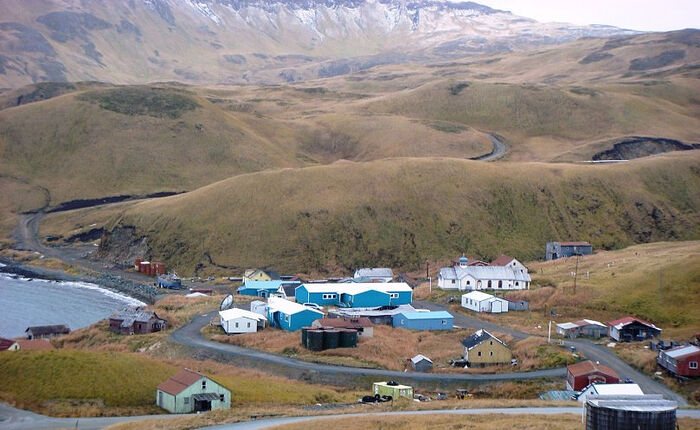 The Church of St. Nicholas on the island of Atka, Western Aleutian Islands, Alaska
The Church of St. Nicholas on the island of Atka, Western Aleutian Islands, Alaska
And what about the kayak? He’s also St. Nicholas the Wet! How many people suffering disasters on the water, whether swimming or traveling, have been saved by the wonderworker! In the eleventh century, a young family was returning by boat along the Dnieper to their native Kiev. The tired mother dozed off and the baby slid out of her hands and into the water. In despair, the parents started praying to St. Nicholas. And what happened? The next day, they found their child, alive and well … in the Cathedral of St. Sophia, next to the icon of St. Nicholas the Wonderworker.
But that’s Kiev, of course! But the saint also went to Alabama, to Buzuluk in Orenburg Province, to New Jersey, to Domodedovo outside Moscow, and to Brisbane in Australia, and to New York…
In the mining town of Brookside, Alabama, where there are a little more than 1,000 people, the St. Nicholas Church of the Moscow Patriarchate was built by Orthodox immigrant workers in 1894. How difficult these 100-plus years of the St. Nicholas Church have been! It has survived hurricanes and fires, the Great Depression, unemployment, the Cold War, and suspicion by the American authorities. For a long time, they couldn’t find a permanent priest for the parish, until Fr. Benedict Tallant arrived in 1965.
By the great labors of Fr. Benedict, a selfless and diligent pastor, and by the prayers of St. Nicholas, the church became a spiritual center in the city and a true home for the parishioners, the majority of whom were Americans who converted as adults, having no Russian roots. And people come to the church from all over Alabama for the annual Slavic Fair held by the Sisterhood of St. Olga.
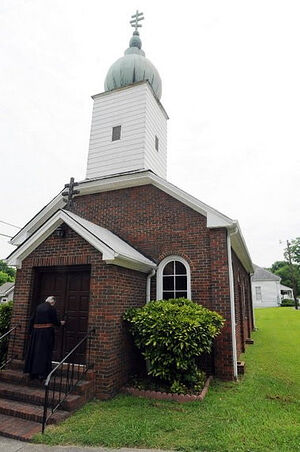 St. Nicholas Church in Brookside, Alabama Mitred Archpriest Benedict Tallant departed to the Lord this year in November, on St. Demetrios Memorial Saturday, but he left behind his last will, a spiritual testament to his parish:
St. Nicholas Church in Brookside, Alabama Mitred Archpriest Benedict Tallant departed to the Lord this year in November, on St. Demetrios Memorial Saturday, but he left behind his last will, a spiritual testament to his parish:
For 120 years, our church has stood as an island of Orthodoxy in a Protestant land. How many Divine Liturgies were served here throughout the years; how many prayer offerings have ascended from the hearts of the faithful children of the Orthodox Church. The peace and comfort of the true faith of Christ have been with us all the days of our lives… The Lord has preserved us. Once abandoned and seemingly isolated, we gradually realized that we are part of the Orthodox family, brothers and sisters to millions of Orthodox from all over the world, and especially part of the great Church of the Russian land—a Church of saints, martyrs, venerable monastics, and faithful servants of Christ…
In 1899, with the blessing of Bishop Tikhon of the Aleutian Islands and Alaska, the future holy Patriarch of Moscow and All Russia, they began building St. Nicholas Cathedral in the center of New York. The first contribution, of 7,500 gold rubles, was made by Tsar Nicholas II. Fr. John of Kronstadt also donated. In his homily during the consecration of the majestic new cathedral in 1902, St. Tikhon said:
“In this great city has been erected a church both worthy of the Russian nation and representative of the greatness of the Orthodox faith.”
In 1914, the first rector of St. Nicholas Cathedral, Hieromartyr Alexander Hotovitsky, helped acquire land for another church of St. Nicholas the Wonderworker in Bayonne, New Jersey. From 1930 to 1940, Metropolitan Benjamin (Fedchenkov), an outstanding hierarch of the Russian Orthodox Church and a wonderful spiritual writer, served there. The current rector of the church in Bayonne is Archpriest Michael Kapchits, who carefully preserves the great traditions of piety:
If, by an inexplicably happy confluence of circumstances, we were allowed to stay in an ancient, beautiful castle, we would at first just tiptoe around it carefully, admiring its extraordinary beauty. Then we would probably know that we would never be able to build anything like this; therefore, we should spend all our efforts on preserving this treasure. So it behooves us, the unprofitable workers of the eleventh hour, to reverently treat the treasury of our Orthodox faith and piety, which was left to us by our all-praiseworthy fathers and which includes all earthly and Heavenly wisdom.
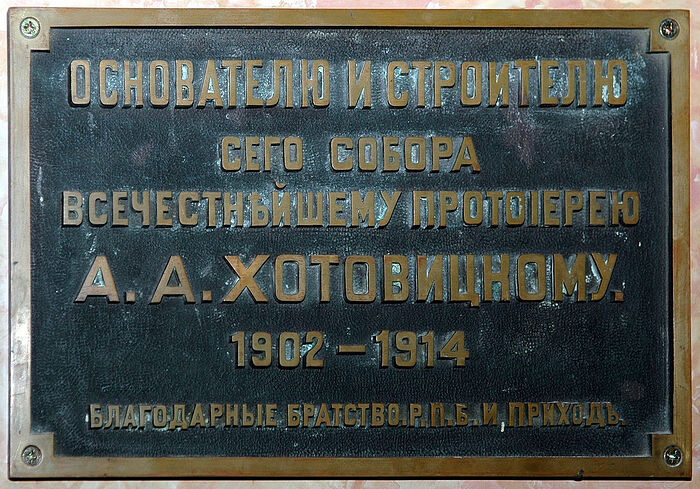 A memorial plaque in memory of Hieromartyr Alexander Hotovitsky, the founder and builder of St. Nicholas Cathedral in New York
A memorial plaque in memory of Hieromartyr Alexander Hotovitsky, the founder and builder of St. Nicholas Cathedral in New York
And they brought a myrrh-streaming icon of St. Nicholas to us at Theophany Cathedral in Boston. The icon began to stream on St. Nicholas’ winter feast, December 19, 1996, in the Church of St. George in Michigan City, Indiana. News of it flew all over Orthodox America, and the icon began its journey around the country. After a few years, St. Nicholas came to Boston. My friends Tolya and Tanya were awaiting him most eagerly of all.
The Moscow students Tolya and Tanya were blessed for marriage by the ever-memorable Metropolitan Pitirim (Nechaev). Vladyka presented the bride and groom with an icon of St. Nicholas he brought from Bari. He married them in my favorite Moscow Church of the Resurrection on Bryusov Lane. Then they received a blessing from the rector, Archpriest Vladimir Romanov, to go study in Boston.
The ever-memorable Fr. Romanov was the rector of St. Nicholas Cathedral in New York from 1992 to 1995, and did much to perpetuate in America the names of St. Tikhon, the Patriarch of Moscow and All Russia, and Hieromartyr Alexander Hotovitsky, the builder and first rector of St. Nicholas Cathedral.
Fr. Vladimir blessed Tolya and Tanya to study in Boston and advised them to go to Holy Theophany Church, to Fr. Roman Lukianov. Their new intriguing life in Boston had begun, with its university cares and a new surroundings, when Tanya suddenly fell ill. It was so difficult that you can’t even talk about it without crying. Fr. Roman and the second priest, Fr. George, often visited her in the hospital. They read akathists and prayed for her recovery. Our entire Holy Theophany Church was praying. Then came St. Nicholas. Fr. Roman brought the myrrh-streaming icon to the hospital, and our Tanya recovered.
“We were so grateful to everyone for their prayers—to Fr. Roman, Fr. George, the whole church, and to St. Nicholas for his help. I was discharged, and my mother and I went to the Holy Land with the Radonezh pilgrimage service. It simply cannot be conveyed in words. The priest who was with us, Fr. John from near Kostroma, was wonderful. He gave us Communion. Everything was so great; my mother and I were as frolicky as fawns.”
In discharging Tanya, the doctors had warned that Tanya and Tolya most likely would not have children…
“For nine months after being in the hospital, I didn’t get my period. And then we went to the River Jordan in the Holy Land; a second Baptism… And that same evening, my period began…”
Several years later, Tanya and Tolya went on pilgrimage to Greece, and they saw an announcement there about a ferry trip to St. Nicholas’ relics in Bari, Italy. They took off on May 23, the day after St. Nicholas’ summer feast.
“For some reason, the church was completely empty. Batiushka served the Liturgy, we communed, we venerated the relics… And three months later, I was pregnant… It’s strange that when we found out we were having a son, we didn’t choose his name immediately. We thought of continuing the tradition of family names. Almost everyone in Tolya’s family is a Paul or an Anatoly. Then there I was in the Boston hospital, about to give birth, and in came the anesthesiologist, an American, of course. And on his badge, I saw the name “Nikolai.” Can you imagine? Not “Nicholas.” Tolya and Tanya asked him:
“Are you Russian?”
“No, not at all,” he said. “My parents just loved Russian classical literature. So I’m Nikolai, and my brother is Alexei.
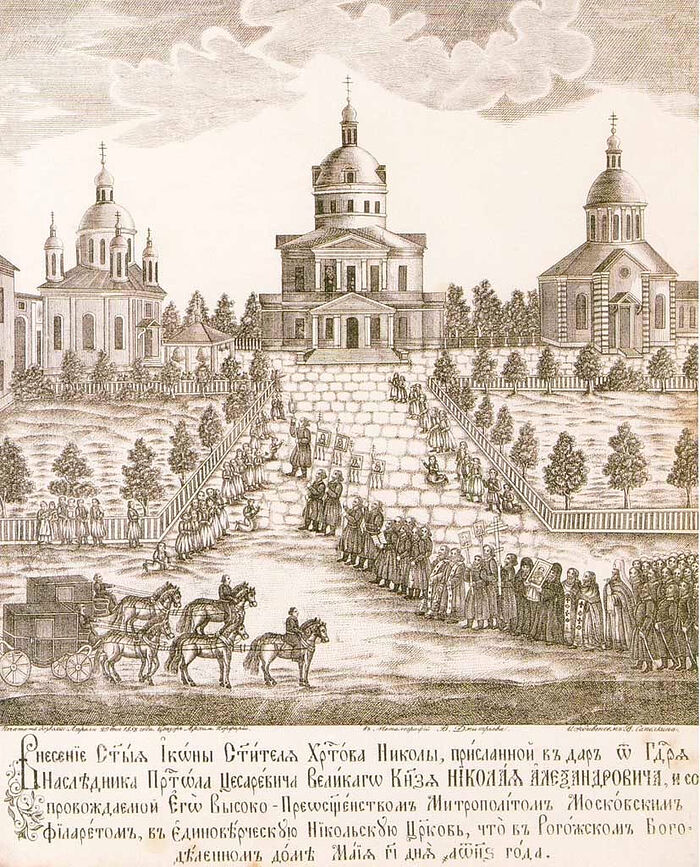 The arrival of the holy icon of St. Nicholas, sent as a gift from Tsarevich Grand Duke Nicholas Alexandrovich, accompanied by Metropolitan Philaret of Moscow, to the St. Nicholas Edinoverie Church at Rogozhka Cemtery
The arrival of the holy icon of St. Nicholas, sent as a gift from Tsarevich Grand Duke Nicholas Alexandrovich, accompanied by Metropolitan Philaret of Moscow, to the St. Nicholas Edinoverie Church at Rogozhka Cemtery
So, Tanya and Tolya had a son Nikolai—my Godson. It seems like just yesterday I was holding him in my arms, and now he’s already a young man, six feet tall. He writes music, he’s studying math in college, and he’s thinking of becoming an architect. He also has a younger brother named Roman.
Thus, “exuding the precious myrrh of mercy and an inexhaustible sea of miracles to the whole world,” St. Nicholas walks the face of the earth, from Alabama to Buzuluk. There are St. Nicholas churches all across the world, and every family has stories of help from the wonderworker of Myra in Lycia.
In Moscow, there is the Church of St. Nicholas in the Rogozhka Cemetery, built with the blessing of St. Philaret of Moscow and the approval of Emperor Nicholas I.
The beautifiers of the church were the Moscow merchants Vladimir Andreevich Sapelkin—the founder of the Izmailovo Military poorhouse and first church warden—and Nikander Matveevich Alasin, a merchant of the First Guild and honorary citizen of Moscow.
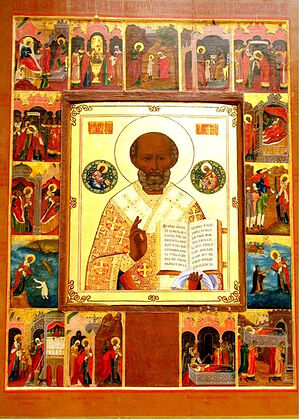 Alasin, the owner of the company Russian Photography company on Volkhonka Street in Moscow, whom Emperor Alexander II permitted to use the image of the Russian coat of arms on the store sign and on photography forms—was truly an example of a pious Russian merchant. Once a month, he had the days that his business would be closed printed in a local Moscow newspaper. For example, this is from August 1863:
Alasin, the owner of the company Russian Photography company on Volkhonka Street in Moscow, whom Emperor Alexander II permitted to use the image of the Russian coat of arms on the store sign and on photography forms—was truly an example of a pious Russian merchant. Once a month, he had the days that his business would be closed printed in a local Moscow newspaper. For example, this is from August 1863:
“We will be closed on the days of the Transfiguration of the Lord, August 6, the Dormition of the Theotokos, August 15, the coronation of the sovereign, August 26, the Beheading of St. John the Forerunner, August 29, and the emperor’s name’s day, August 30.”
So, in this church on Rogozhka, which has become, by the efforts of its benefactors, the Moscow merchants Salepkin, Alasin, and others, so beautiful that it resembles a precious chest or a house from a fairytale, there is an extraordinary icon of St. Nicholas the Wonderworker—Nicholas the Ever-Active.
The icon, given to the church by Grand Duke Nicholas Alexandrovich, the son of Emperor Alexander II, and delivered by St. Philaret, includes hagiographical scenes. Only, there aren’t sixteen scenes as there should be, but fifteen. One scene is empty. The iconographer left room for a new miracle of St. Nicholas the Ever-Active.
My mother, who lived in the Domodedovo District of the Moscow Province for about fifteen years, often went to the village Church of St. Nicholas. In the ancient village of Domodedovo, which is more than 600 years old, the first church was built in 1658, and the current stone church was erected in 1738 (the dilapidated bell tower and trapeza were built in 1837). It was in this church, which never closed during the soviet era, that my mother and I first saw an ancient icon of the holy hierarch saving a drowning baby. In this church, where the ever-memorable kindly Archpriest Nikolai Slozhenikin was serving, my mother met a parishioner who had her own story about the intervention of St. Nicholas.
Elderly and unusually friendly, this woman always stood in the same place in church, by the Burning Bush Icon of the Mother of God.
“Yes, my dear, my mother, who is now reposed, always stood in this spot. And now I don’t even remember how many years I’ve been standing here… My parents had three young sons. It was the years of the famine, and my father went to the city to earn a living. Not long after he left, my mama realized she was pregnant with the fourth child. What to do? It was winter, she had no way of contacting my father, there was nothing to feed the three boys with, and now there was another child on the way. Basically, she decided to go to the doctor in the next village over to have an abortion. And what do you think? Her legs swelled up so much that she couldn’t even get up, let alone go anywhere. The next morning, there was a knock at the door. It was a shepherd from some village; he had brought some bread. And the next morning, and the next. He would come and, without saying a word, give us bread, some other food, and for the youngest child—a bublik, or some gingerbread, then he would quickly leave. This lasted all winter. And mama lay there with sore legs until she gave birth. My father returned from working, and mama had given birth to me. And as soon as she recovered, she got on a horse and went around to all the neighboring villages, looking for the shepherd, so she could thank him. She visited all the villages, my dear, and no one has ever seen this shepherd. It was St. Nicholas himself. And mama started bringing me to this church just after I was born. She would bring all of us children and she would stand by the Burning Bush—and she would stand there the whole Liturgy, without moving. I was young, antsy. I would start spinning around, sitting on the floor, and she would pick me up: “Stand up, you fool!” I mean, of course, she said it with kindness, sweetly, with love…

